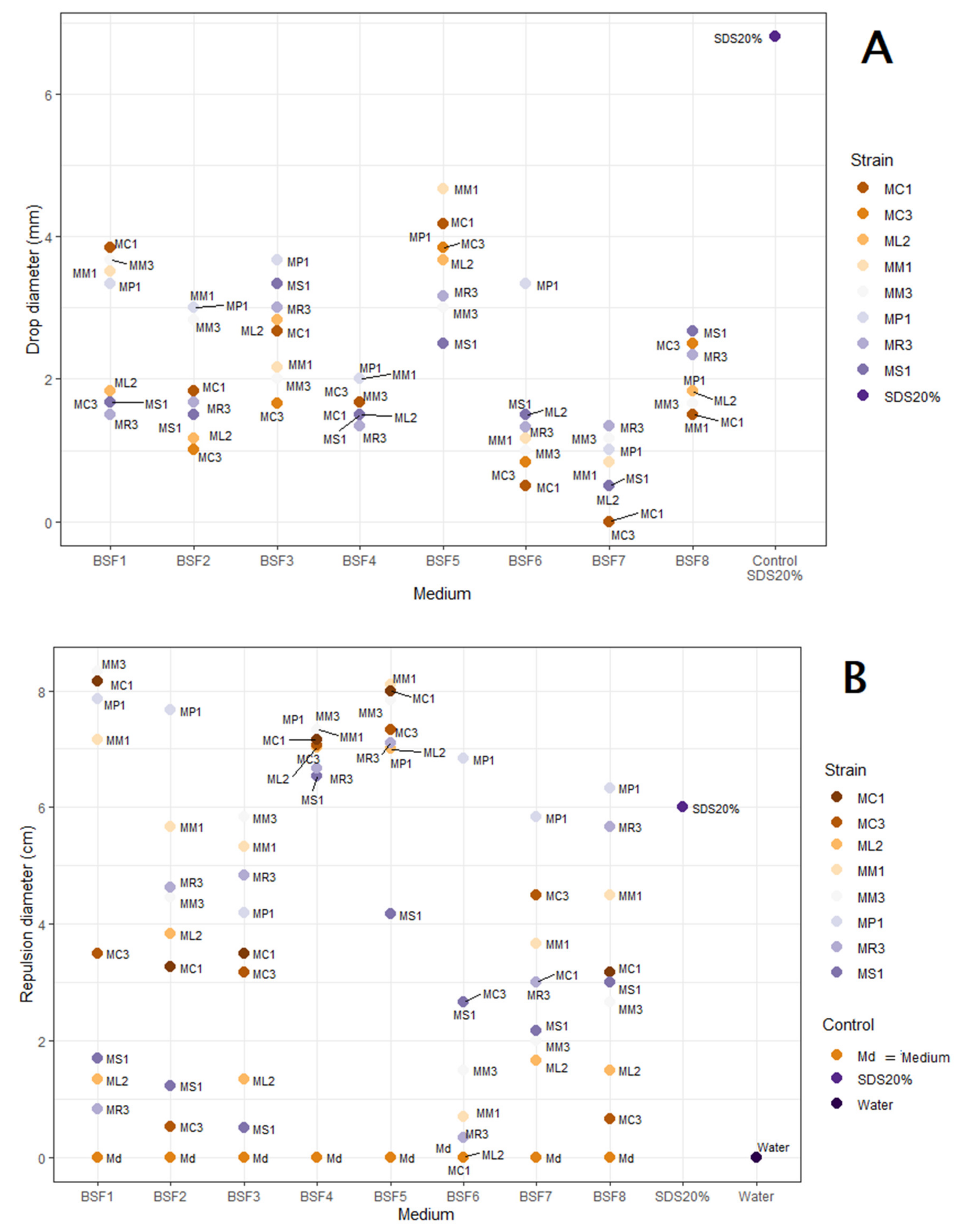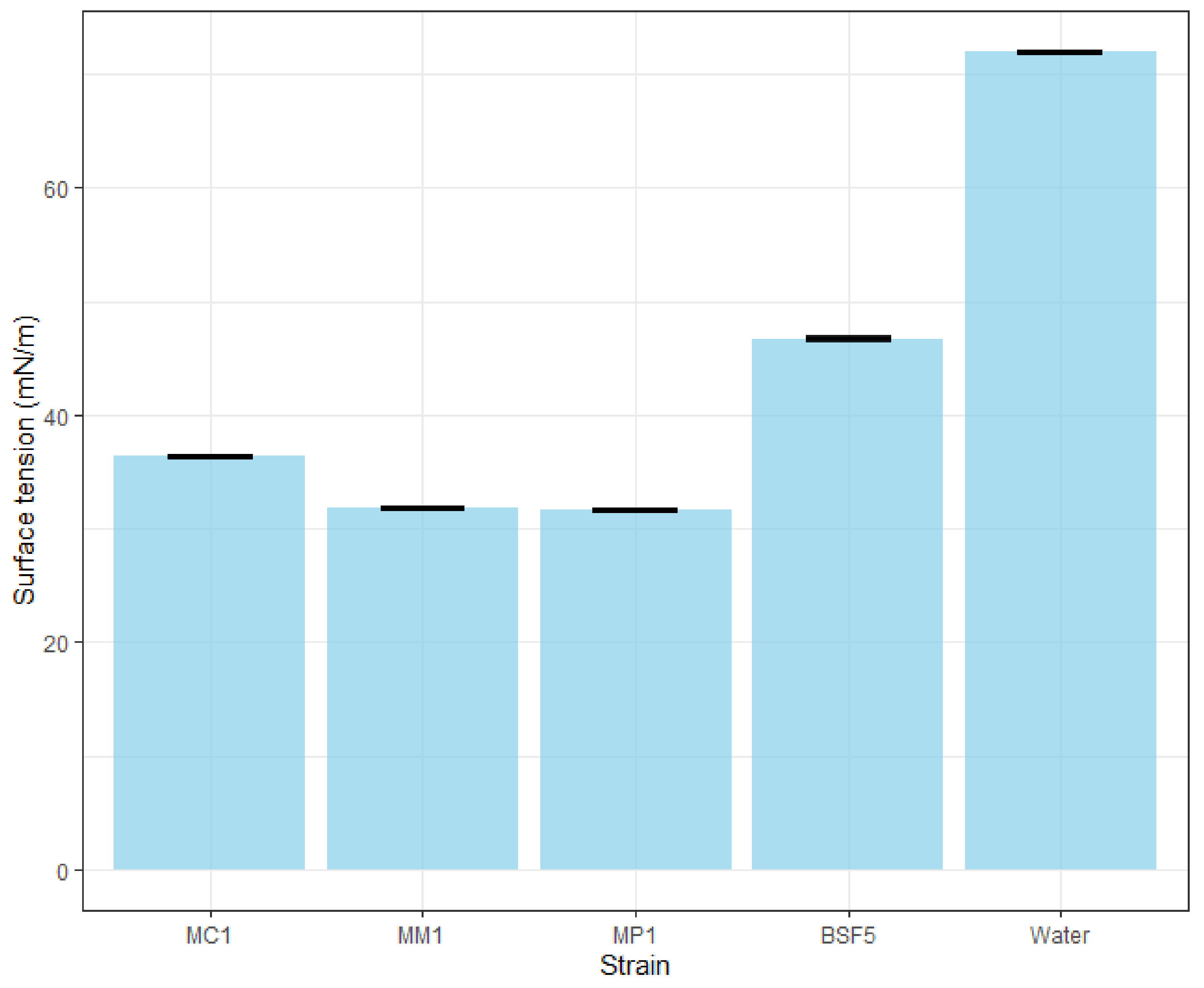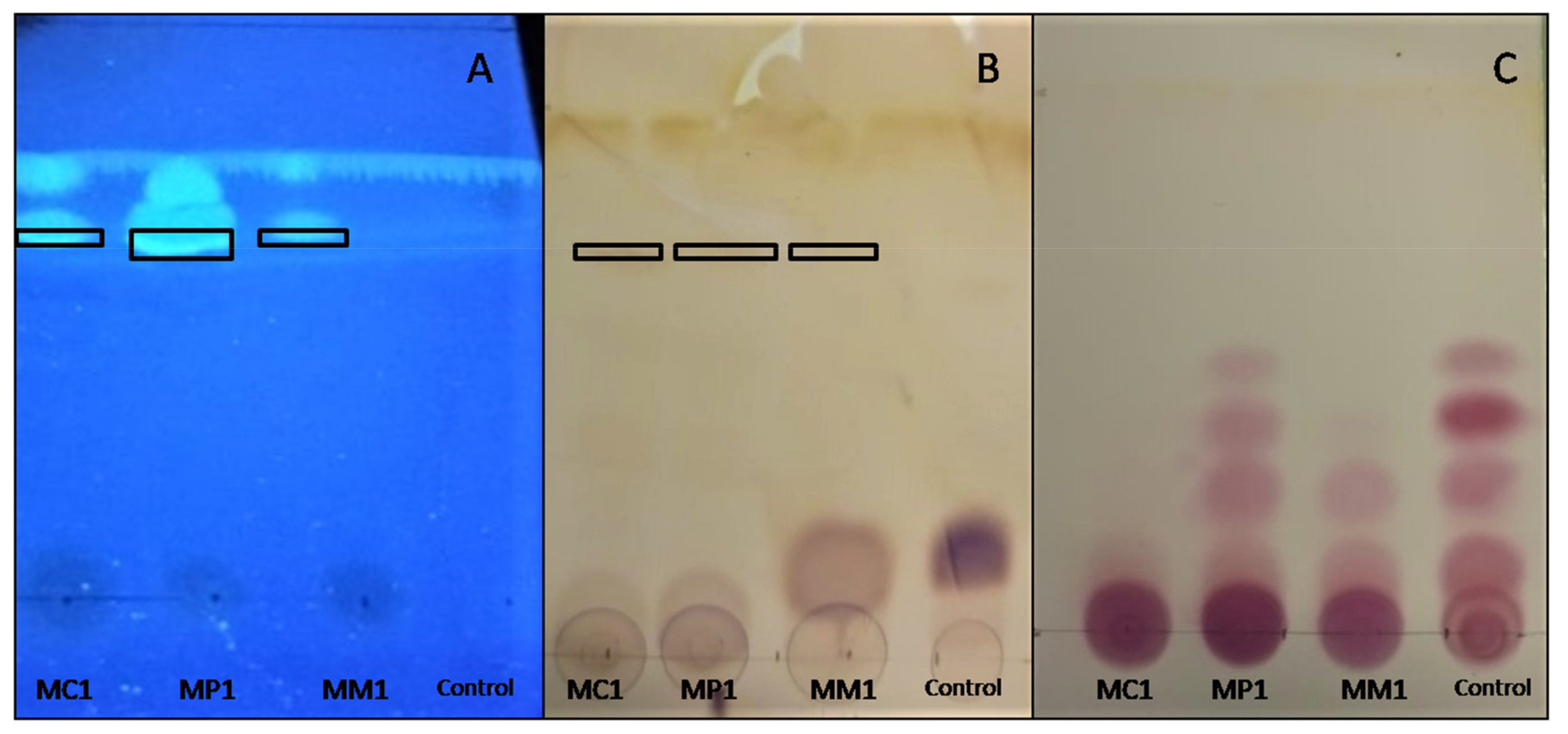Biosurfactant-Producing Mucor Strains: Selection, Screening, and Chemical Characterization
Abstract
1. Introduction
2. Materials and Methods
2.1. Fungal Strains and Spore Suspension Preparation
2.2. Cultivation Media and Growth Conditions
2.2.1. Preliminary Screening of Surfactant Production
2.2.2. Impact of Medium Composition on Surfactant Production,
2.3. Detection of Surface-Active Compounds in Culture Supernatants
2.3.1. Oil Spreading Test (OST)
2.3.2. Parafilm M Test
2.3.3. Emulsification Index (E24)
2.3.4. Surface Tension Measurement
2.4. Biosurfactant Extraction
2.5. Chemical Characterization by Thin Layer Chromatography (TLC)
2.6. Statistical Analysis
3. Results
3.1. Qualitative Screening of Surface Active Compound Production
3.2. Impact of Medium Composition
3.3. Surface-Tension Reducing and Emulsifying Activities
3.4. Chemical Characterization by TLC
4. Discussion
5. Conclusions
Supplementary Materials
Author Contributions
Funding
Institutional Review Board Statement
Informed Consent Statement
Data Availability Statement
Acknowledgments
Conflicts of Interest
References
- Naughton, P.; Marchant, R.; Naughton, V.; Banat, I. Microbial biosurfactants: Current trends and applications in agricultural and biomedical industries. J. Appl. Microbiol. 2019, 127, 12–28. [Google Scholar] [CrossRef] [PubMed]
- Twigg, M.S.; Baccile, N.; Banat, I.M.; Déziel, E.; Marchant, R.; Roelants, S.; Van Bogaert, I.N.A. Microbial biosurfactant research: Time to improve the rigour in the reporting of synthesis, functional characterization and process development. Microb. Biotechnol. 2020, 14, 147–170. [Google Scholar] [CrossRef] [PubMed]
- Sanches, M.A.; Luzeiro, I.G.; Cortez, A.C.A.; de Souza, S.; Albuquerque, P.M.; Chopra, H.K.; de Souza, J.V.B. Production of Biosurfactants by Ascomycetes. Int. J. Microbiol. 2021, 2021, 6669263. [Google Scholar] [CrossRef] [PubMed]
- Akbari, S.; Abdurahman, N.H.; Yunus, R.M.; Fayaz, F.; Alara, O.R. Biosurfactants—A new frontier for social and environmental safety: A mini review. Biotechnol. Res. Innov. 2018, 2, 81–90. [Google Scholar] [CrossRef]
- Dell’Anno, F.; Sansone, C.; Ianora, A. Biosurfactant-induced remediation of contaminated marine sediments: Current knowledge and future perspectives. Mar. Environ. Res. 2018, 137, 196–205. [Google Scholar] [CrossRef]
- Jahan, R.; Bodratti, A.M.; Tsianou, M.; Alexandridis, P. Biosurfactants, natural alternatives to synthetic surfactants: Physicochemical properties and applications. Adv. Colloid Interface Sci. 2019, 275, 102061. [Google Scholar] [CrossRef]
- Moutinho, L.F.; Moura, F.R.; Silvestre, R.C.; Romão-Dumaresq, A.S. Microbial biosurfactants: A broad analysis of properties, applications, biosynthesis, and techno-economical assessment of rhamnolipid production. Biotechnol. Prog. 2021, 37, e3093. [Google Scholar] [CrossRef]
- Perfumo, A.; Smyth, T.J.P.; Marchant, R.; Banat, I.M. Production and Roles of biosurfactants and bioemulsifiers in accessing hydrophobic substrates. In Handbook of Hydrocarbon and Lipid Microbiology; Springer: Cham, Switzerland, 2010; pp. 1501–1512. [Google Scholar] [CrossRef]
- Banat, I.; Banat, I.M.; Franzetti, A.; Gandolfi, I.; Bestetti, G.; Martinotti, M.G.; Fracchia, L.; Smyth, T.J.; Marchant, R. Microbial biosurfactant production, applications and future potential. Appl. Microbiol. Biotechnol. 2010, 87, 427–444. [Google Scholar] [CrossRef]
- Drakontis, C.E.; Amin, S. Biosurfactants: Formulations, Properties, and Applications. Curr. Opin. Colloid Interface Sci. 2020, 48, 77–90. [Google Scholar] [CrossRef]
- Kiran, S.; Hema, T.A.; Gandhimathi, R.; Selvin, J.; Thomas, T.A.; Ravji, T.R.; Natarajaseenivasan, K. Optimization and production of a biosurfactant from the sponge-associated marine fungus Aspergillus ustus MSF3. Colloids Surf. B Biointerfaces 2009, 73, 250–256. [Google Scholar] [CrossRef]
- Bhardwaj, G.; Cameotra, S.S.; Chopra, H.K. Biosurfactants from Fungi: A Review. J. Pet. Environ. Biotechnol. 2013, 4, 1–6. [Google Scholar] [CrossRef]
- Luft, L.; Confortin, T.C.; Todero, I.; Zabot, G.L.; Mazutti, M.A. An overview of fungal biopolymers: Bioemulsifiers and biosurfactants compounds production. Crit. Rev. Biotechnol. 2020, 40, 1059–1080. [Google Scholar] [CrossRef]
- Walther, G.; Pawłowska, J.; Alastruey-Izquierdo, A.; Wrzosek, M.; Rodriguez-Tudela, J.; Dolatabadi, S.; Chakrabarti, A.; de Hoog, G. DNA barcoding in Mucorales: An inventory of biodiversity. Pers.—Mol. Phylogeny Evol. Fungi 2013, 30, 11–47. [Google Scholar] [CrossRef]
- Wagner, L.; Stielow, J.; De Hoog, G.; Bensch, K.; Schwartze, V.U.; Voigt, K.; Alastruey-Izquierdo, A.; Kurzai, O.; Walther, G. A new species concept for the clinically relevant Mucor circinelloides complex. Pers.—Mol. Phylogeny Evol. Fungi 2020, 44, 67–97. [Google Scholar] [CrossRef]
- Lee Taylor, D.; Sinsabaugh, R.L. Chapter 4—The soil fungi: Occurrence, phylogeny, and ecology. In Soil Microbiology, Ecology and Biochemistry, 4th ed.; Paul, E.A., Ed.; Academic Press: Boston, MA, USA, 2015; pp. 77–109. [Google Scholar]
- Morin-Sardin, S.; Nodet, P.; Coton, E.; Jany, J.-L. Mucor: A Janus-faced fungal genus with human health impact and industrial applications. Fungal Biol. Rev. 2017, 31, 12–32. [Google Scholar] [CrossRef]
- Kosa, G.; Zimmermann, B.; Kohler, A.; Ekeberg, D.; Afseth, N.K.; Mounier, J.; Shapaval, V. High-throughput screening of Mucoromycota fungi for production of low- and high-value lipids. Biotechnol. Biofuels 2018, 11, 66. [Google Scholar] [CrossRef]
- Hasani Zadeh, P.; Moghimi, H.; Hamedi, J. Biosurfactant production by Mucor circinelloides: Environmental applications and surface-active properties. Eng. Life Sci. 2018, 18, 317–325. [Google Scholar] [CrossRef]
- Ferreira, I.N.S.; Rodríguez, D.M.; Campos-Takaki, G.M.; Andrade, R.F.D.S. Biosurfactant and bioemulsifier as promising molecules produced by Mucor hiemalis isolated from Caatinga soil. Electron. J. Biotechnol. 2020, 47, 51–58. [Google Scholar] [CrossRef]
- Oje, O.A.; Okpashi, V.E.; Uzor, J.C.; Uma, U.O.; Irogbolu, A.O.; Onwurah, I.N. Effect of Acid and Alkaline Pretreatment on the Production of Biosurfactant from Rice Husk Using Mucor indicus. Res. J. Environ. Toxicol. 2016, 10, 60–67. [Google Scholar] [CrossRef][Green Version]
- Morikawa, M.; Hirata, Y.; Imanaka, T. A study on the structure–function relationship of lipopeptide biosurfactants. Biochim. Biophys. Acta (BBA)—Mol. Cell Biol. Lipids 2000, 1488, 211–218. [Google Scholar] [CrossRef]
- Yalçın, H.T.; Ergin-Tepebaşı, G.; Uyar, E. Isolation and molecular characterization of biosurfactant producing yeasts from the soil samples contaminated with petroleum derivatives. J. Basic Microbiol. 2018, 58, 782–792. [Google Scholar] [CrossRef] [PubMed]
- Marques, N.S.A.A.; Da Silva, I.G.S.; Cavalcanti, D.L.; Maia, P.C.S.V.; Santos, V.P.; Andrade, R.F.S.; Campos-Takaki, G.M. Eco-Friendly Bioemulsifier Production by Mucor circinelloides UCP0001 Isolated from Mangrove Sediments Using Renewable Substrates for Environmental Applications. Biomolecules 2020, 10, 365. [Google Scholar] [CrossRef] [PubMed]
- Ahmad, Z.; Arshad, M.; Asghar, H.N.; Sheikh, M.A.; Crowley, D.E.; Ali, S.; Malik, M.A.; Ansar, M.; Qureshi, R. Isolation, Screening and Functional Characterization of Biosurfactant Producing Bacteria Isolated from Crude Oil Contaminated Site. Int. J. Agric. Biol. 2016, 18, 542–548. [Google Scholar] [CrossRef]
- Schulz, D.; Passeri, A.; Schmidt, M.; Lang, S.; Wagner, F.; Wray, V.; Gunkel, W. Marine Biosurfactants, I. Screening for Biosurfactants among Crude Oil Degrading Marine Microorganisms from the North Sea. Z. Naturforsch. C J. Biosci. 1991, 46, 197–203. [Google Scholar] [CrossRef]
- Satpute, S.K.; Banpurkar, A.G.; Dhakephalkar, P.K.; Banat, I.M.; Chopade, B.A. Methods for investigating biosurfactants and bioemulsifiers: A review. Crit. Rev. Biotechnol. 2010, 30, 127–144. [Google Scholar] [CrossRef]
- Fox, J. The R Commander: A Basic Statistics Graphical User Interface to R. J. Stat. Softw. 2005, 14, 1–42. [Google Scholar] [CrossRef]
- Alves, M.; Campos-Takaki, G.M.; Porto3, A.L.F.; Milanez, A.I. Screening of Mucor spp. for the production of amylase, lipase, polygalacturonase and protease. Braz. J. Microbiol. 2002, 33, 325–330. [Google Scholar] [CrossRef]
- De Oliveira Schmidt, V.K.; Carvalho, J.D.S.; De Oliveira, D.; De Andrade, C.J. Biosurfactant inducers for enhanced production of surfactin and rhamnolipids: An overview. World J. Microbiol. Biotechnol. 2021, 37, 21. [Google Scholar] [CrossRef]



| Strain Number | Species | Isolation Source | Strain Code |
|---|---|---|---|
| UBOCC-A-109190 | Mucor circinelloides | Insect | MC1 |
| UBOCC-A-109191 | Mucor circinelloides | Sediments | MC2 |
| UBOCC-A-109192 | Mucor circinelloides | Air | MC3 |
| UBOCC-A-109193 | Mucor lanceolatus | Raclette cheese | ML1 |
| UBOCC-A-110148 | Mucor lanceolatus | Brie cheese rind | ML2 |
| UBOCC-A-101355 | Mucor lanceolatus | Unknown | ML3 |
| UBOCC-A-109195 | Mucor spinosus | Cheese | MS1 |
| UBOCC-A-101363 | Mucor spinosus | Unknown | MS2 |
| UBOCC-A-109212 | Mucor racemosus | Cheese | MR1 |
| UBOCC-A-109213 | Mucor racemosus | Cheese rind | MR2 |
| UBOCC-A-109214 | Mucor racemosus | Yoghurt | MR3 |
| UBOCC-A-111133 | Mucor plumbeus | Fresh dairy product | MP1 |
| UBOCC-A-111125 | Mucor plumbeus | Air | MP2 |
| UBOCC-A-111128 | Mucor plumbeus | Fresh dairy product | MP3 |
| UBOCC-A-101364 | Mucor brunneogriseus | Unknown | MB1 |
| UBOCC-A-102004 | Mucor brunneogriseus | Eggs | MB2 |
| UBOCC-A-109052 | Mucor brunneogriseus | Soil | MB3 |
| UBOCC-A-101353 | Mucor mucedo | Unknown | MM1 |
| UBOCC-A-101361 | Mucor mucedo | Cow feces | MM2 |
| UBOCC-A-101362 | Mucor mucedo | Maize | MM3 |
| UBOCC-A-102006 | Lichtheimia corymbifera | Eggs | AC |
| UBOCC-A-101332 | Lichtheimia spinosa | Air | AS |
| UBOCC-A-101331 | Lichtheimia ramosa | Cow digestive tract | AR |
| UBOCC-A-101330 | Absidia glauca | Rumen | AG |
| Medium | Glucose (g/L) | Yeast Extract (g/L) | Canola Oil (g/L) | Groundnut oil (g/L) | Linseed Oil (g/L) |
|---|---|---|---|---|---|
| BSF1 | 20 | 5 | 5 | 0 | 0 |
| BSF2 | 20 | 2.5 | 5 | 0 | 0 |
| BSF3 | 5 | 5 | 10 | 0 | 0 |
| BSF4 | 5 | 5 | 15 | 0 | 0 |
| BSF5 | 5 | 5 | 20 | 0 | 0 |
| BSF6 | 20 | 5 | 20 | 0 | 0 |
| BSF7 | 5 | 5 | 0 | 15 | 0 |
| BSF8 | 5 | 5 | 0 | 0 | 15 |
| Species | Strain Code | Oil Spreading Test | Parafilm M Test |
|---|---|---|---|
| Mucor circinelloides | MC1 | + * | + |
| MC2 | - | - | |
| MC3 | - | + | |
| Mucor lanceolatus | ML1 | - | - |
| ML2 | + | + | |
| ML3 | - | + | |
| Mucor spinosus | MS1 | - | ++ |
| MS2 | - | - | |
| Mucor mucedo | MM1 | - | + |
| MM2 | - | + | |
| MM3 | + | ++ | |
| Mucor racemosus | MR1 | - | - |
| MR2 | - | - | |
| MR3 | + | + | |
| Mucor plumbeus | MP1 | + | + |
| MP2 | - | - | |
| MP3 | - | - | |
| Mucor brunneogriseus | MB1 | - | - |
| MB2 | - | - | |
| MB3 | - | - | |
| Lichtheimia corymbifera | AC | - | - |
| Lichtheimia spinosa | AS | - | - |
| Lichtheimia ramosa | AR | - | - |
| Absidia glauca | AG | - | - |
Publisher’s Note: MDPI stays neutral with regard to jurisdictional claims in published maps and institutional affiliations. |
© 2022 by the authors. Licensee MDPI, Basel, Switzerland. This article is an open access article distributed under the terms and conditions of the Creative Commons Attribution (CC BY) license (https://creativecommons.org/licenses/by/4.0/).
Share and Cite
Chotard, M.; Mounier, J.; Meye, R.; Padel, C.; Claude, B.; Nehmé, R.; Da Silva, D.; Floch, S.L.; Lucchesi, M.-E. Biosurfactant-Producing Mucor Strains: Selection, Screening, and Chemical Characterization. Appl. Microbiol. 2022, 2, 248-259. https://doi.org/10.3390/applmicrobiol2010018
Chotard M, Mounier J, Meye R, Padel C, Claude B, Nehmé R, Da Silva D, Floch SL, Lucchesi M-E. Biosurfactant-Producing Mucor Strains: Selection, Screening, and Chemical Characterization. Applied Microbiology. 2022; 2(1):248-259. https://doi.org/10.3390/applmicrobiol2010018
Chicago/Turabian StyleChotard, Mélanie, Jérôme Mounier, Raissa Meye, Carole Padel, Bérengère Claude, Reine Nehmé, David Da Silva, Stéphane Le Floch, and Marie-Elisabeth Lucchesi. 2022. "Biosurfactant-Producing Mucor Strains: Selection, Screening, and Chemical Characterization" Applied Microbiology 2, no. 1: 248-259. https://doi.org/10.3390/applmicrobiol2010018
APA StyleChotard, M., Mounier, J., Meye, R., Padel, C., Claude, B., Nehmé, R., Da Silva, D., Floch, S. L., & Lucchesi, M.-E. (2022). Biosurfactant-Producing Mucor Strains: Selection, Screening, and Chemical Characterization. Applied Microbiology, 2(1), 248-259. https://doi.org/10.3390/applmicrobiol2010018








